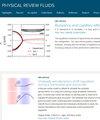Stability of gravity-driven viscous films flowing down a soft cylinder
IF 2.5
3区 物理与天体物理
Q2 PHYSICS, FLUIDS & PLASMAS
引用次数: 0
Abstract
We study the stability of gravity-driven viscous liquid films flowing down a vertical cylinder that is uniformly coated with a thin layer of elastic solids. Combining the gravity-driven viscous flows with the elastic deformation of the coated soft layer, we formulate a long-wave model to describe the evolution of a film flow-soft structure coupled system. Based on the model, we systematically examine the impact of the coating properties, including the elasticity and thickness on the temporal and spatiotemporal stability. Temporal stability analysis shows that the soft layer plays a dual role, namely, the elasticity acts as a destabilizing factor, leading to large deformations of both film interface and soft surface. However, due to the geometrical effect, increasing the layer thickness stabilizes the Rayleigh-Plateau instability. By contrast, the linear phase speed is always enhanced with increasing the elasticity or the thickness of the coated layer. We then analyze the spatiotemporal nature of free-surface instabilities and find that the elasticity can trigger the film flows from being absolutely unstable to convectively unstable. Transient numerical solutions of the full asymptotic model further verify the predictions from linear stability analysis, and more importantly, reveal the nonlinear effect of the softness. Compared to liquid films falling down the cylinder with rigid walls, the soft surface can enhance the coalescence of faster, larger sliding droplets with preceding slower, smaller sliding ones, thus resulting in a more unstable system. Our study highlights the potential of coating a thin layer of soft materials onto the walls of substrate to regulate the dynamics of liquid film systems, and may have implications for the emerging bioinspired applications; for instance, the large-scale collection and transport of water on flexible microfiber arrays.

重力驱动的粘性薄膜在软圆筒中流动的稳定性
我们研究了重力驱动的粘性液膜沿垂直圆柱体流下的稳定性,该圆柱体上均匀地涂覆了一层弹性固体薄层。结合重力驱动的粘性流动和涂层软层的弹性变形,我们建立了一个长波模型来描述薄膜流动-软结构耦合系统的演变。基于该模型,我们系统地研究了涂层特性(包括弹性和厚度)对时空稳定性的影响。时空稳定性分析表明,软层起着双重作用,即弹性是一个失稳因素,会导致薄膜界面和软表面产生较大变形。然而,由于几何效应,增加软层厚度会使瑞利-高原不稳定性趋于稳定。相比之下,线性相位速度总是随着弹性或涂层厚度的增加而提高。然后,我们分析了自由表面不稳定性的时空性质,发现弹性会引发薄膜流从绝对不稳定到对流不稳定。全渐近模型的瞬态数值解进一步验证了线性稳定性分析的预测,更重要的是揭示了软性的非线性效应。与液膜从具有刚性壁的圆柱体上落下相比,软表面能增强速度较快、较大的滑动液滴与前面速度较慢、较小的滑动液滴的凝聚,从而导致系统更不稳定。我们的研究强调了在基底壁上涂一层薄薄的软材料来调节液膜系统动力学的潜力,并可能对新兴的生物启发应用产生影响;例如,在柔性微纤维阵列上大规模收集和运输水。
本文章由计算机程序翻译,如有差异,请以英文原文为准。
求助全文
约1分钟内获得全文
求助全文
来源期刊

Physical Review Fluids
Chemical Engineering-Fluid Flow and Transfer Processes
CiteScore
5.10
自引率
11.10%
发文量
488
期刊介绍:
Physical Review Fluids is APS’s newest online-only journal dedicated to publishing innovative research that will significantly advance the fundamental understanding of fluid dynamics. Physical Review Fluids expands the scope of the APS journals to include additional areas of fluid dynamics research, complements the existing Physical Review collection, and maintains the same quality and reputation that authors and subscribers expect from APS. The journal is published with the endorsement of the APS Division of Fluid Dynamics.
 求助内容:
求助内容: 应助结果提醒方式:
应助结果提醒方式:


